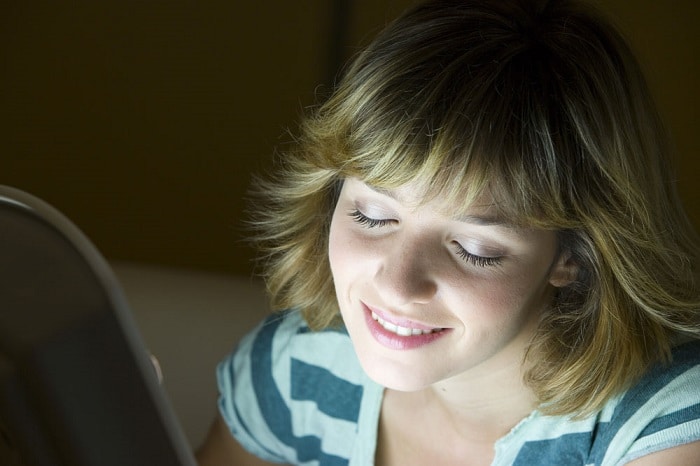Color therapy presents us with a holistic form of healing in which the visible light spectrum is used to influence frequencies and energies within our bodies.
Our brains and eyes are always hard at work. Light receptors in the human eyes send messages to the brain that result in the perception of different colors. We are not always fully conscious of how we perceive these colors or even the fact that the absence of bright light during cold winter months can cause us to feel a type of depression commonly referred to as Seasonal Affective Disorder (SAD).

What Is Color Therapy?
Color therapy (also known as light therapy or chromotherapy) is a method for treating various psychiatric disorders. It operates on the theory that each color produces a different response in people with emotional disorders. The theory suggests that if any color (or chakra associated with it) is not in balance, the mind and body become imbalanced as well.
Take, for example, the color green. It falls right in the middle of the visible light spectrum. Therefore, it acts as a balance between the relaxing cooler colors and invigorating warmer colors. Green is thought to bring a sense of inner harmony to the individual and also associates with the heart chakra (or Anahata).
During a color therapy session, a color therapist will apply lights to certain parts of the body using specific lens colors. The procedure is non-invasive and safe. Also, it can be used in conjunction with any other type of mental and/or physical health treatment.
The History of Color Therapy
Color therapy has its roots in Ancient Greece, Rome, India, and China.
- In Ancient Egyptian mythology, the god Thoth discovered the healing art of color therapy.
- Charaka, the founder of Ayurvedic medicine in Ancient India, often recommended sun exposure treatment for his patients had a variety of diseases.
- To the Ancient Greeks, restoring a balance of health and wellness meant utilizing colors in their oils, salves, and other forms of treatment.
By the 19th century AD, color theory came onto the scene in western culture. Augustus James Pleasanton owns the credits for developing color theory for more modern times. This is even though he only utilized the color blue. Edwin Dwight Babbitt expanded upon this theory. In the 1870s, he wrote in several publications that he believed colors directly influence human beings.
In the 20th century, Dinshah Pestanji Ghadiali, Charles Klotsche, Khawaja Shamsuddin Azeemi, and Hassan adapted color therapy into the healing forms in usage to treat people today.
Evidence of How Color Therapy Helps
The verdict is still out on whether color therapy is truly an effective form of healing. There is some evidence that colors can elicit certain emotional responses and impact our perception. However, available literature is slightly confusing. Practitioners don’t always commonly agree on the attributes of specific colors. So, there are variations in responses to colors by different individuals that make color therapy hard to scientifically support.
Color therapy has, however, shown potential benefits in treating those with:
- Depression;
- Chronic pain;
- Insomnia or other sleep issues;
- Anxiety.
Additionally, researchers found that yellow light can help treat vision problems. This is because it filters out blue light which causes night blindness.
Also, those with COPD, bronchitis, asthma, and other respiratory ailments have been reported to benefit from the use of the color orange. This stimulates both the thyroid gland and the lungs. Consequently, it is increasing the body’s oxygen level.
Other Issues That Relate to Color Therapy
In addition to treating a host of psychiatric disorders, color therapy has been in usage to:
- Treat soft tissue injuries (such as muscle spasms and bursitis);
- Reduce pain and promote healing after surgery;
- Reduce lower back pain;
- Improve the body’s wound healing abilities;
- Clear up symptoms of skin disorders (such as eczema and psoriasis);
- Combat chronic fatigue syndrome;
- Reduce inflammation and pressure sores in babies.

Color Therapy Treatment Options
Currently, the U.S. Food and Drug Administration classifies the low-level laser therapy (LLLT) lights used in color therapy as Class II devices for pain therapy. During therapy, these LLLTs are placed over the surface of the skin for a set period of time. There are companies manufacturing LLLTs for at-home color therapy. These LLLT devices are hand-held or can be placed on tabletops.
Before starting color therapy, a specialist should go over how the lights and colors work and help a client identify their wellness targets. The therapist should then assist in setting up a treatment program that:
- Seeks to restore depleted energy reserves in the body;
- Support the client’s power of resistance;
- Restore vitality and functioning to skin and other bodily tissues;
- Improve the body’s metabolic rate;
- Create an overall sense of inner well-being and serenity.
Color Therapy in Popular Media
Celebrities are catching on to and promoting the use of color therapy for healing purposes. In 2016, actress Kate Hudson started using the cell phone app Snapchat to document her experiences with using an LED light face mask to treat acne and enhance the amount of collagen created.
Before Hudson started documenting her LED light face mask treatments online, actress Jessica Alba began promoting this type of therapy. Alba and Hudson brought it to the forefront of treatment options. So, Chrissy Teigen, Kourtney Kardashian, and countless other women and men have started using color therapy to improve their physical and mental health.
To the Colors
If someone is struggling with Seasonal Affective Disorder, anxiety, or an array of physical health issues, they might benefit from using color therapy. Of course, if they decide to use this treatment, they should first speak with a trained color therapist before trying the treatment either in their office or at home.
Color therapy might just help them brighten up their life.
The images are from depositphotos.com.
